
AI workflow orchestration is the backbone of modern artificial intelligence systems, ensuring seamless integration across models, data sources, and processes. Unlike rigid traditional workflows, AI orchestration adapts dynamically, automating tasks, connecting systems, and optimizing decision-making. Below are 9 leading platforms for AI workflow orchestration, each offering unique features to meet specific organizational needs:
| Platform | Key Strengths | Best For | Complexity |
|---|---|---|---|
| Prompts.ai | Multi-model support, cost efficiency | AI tool consolidation | Low |
| Kubeflow | Kubernetes-native, MLOps tools | DevOps-heavy teams | High |
| Apache Airflow | Task scheduling, plugin ecosystem | General workflow management | Medium |
| Prefect Orion | Cloud-agnostic, modern interface | Hybrid cloud deployments | Medium |
| Flyte | Reproducible workflows, data lineage | Research-focused organizations | High |
| CrewAI | Multi-agent coordination | Agent-centric workflows | Low |
| IBM watsonx | Enterprise governance, IBM ecosystem | IBM-centric enterprises | Medium |
| Workato | Business process automation | Business-driven AI workflows | Medium |
| Cloud-native Tools | Seamless ecosystem integration | Cloud-first enterprises | Medium |
These platforms cater to diverse needs, from cost savings and governance to scalability and integration. Choose based on your organization’s goals, technical expertise, and existing infrastructure.
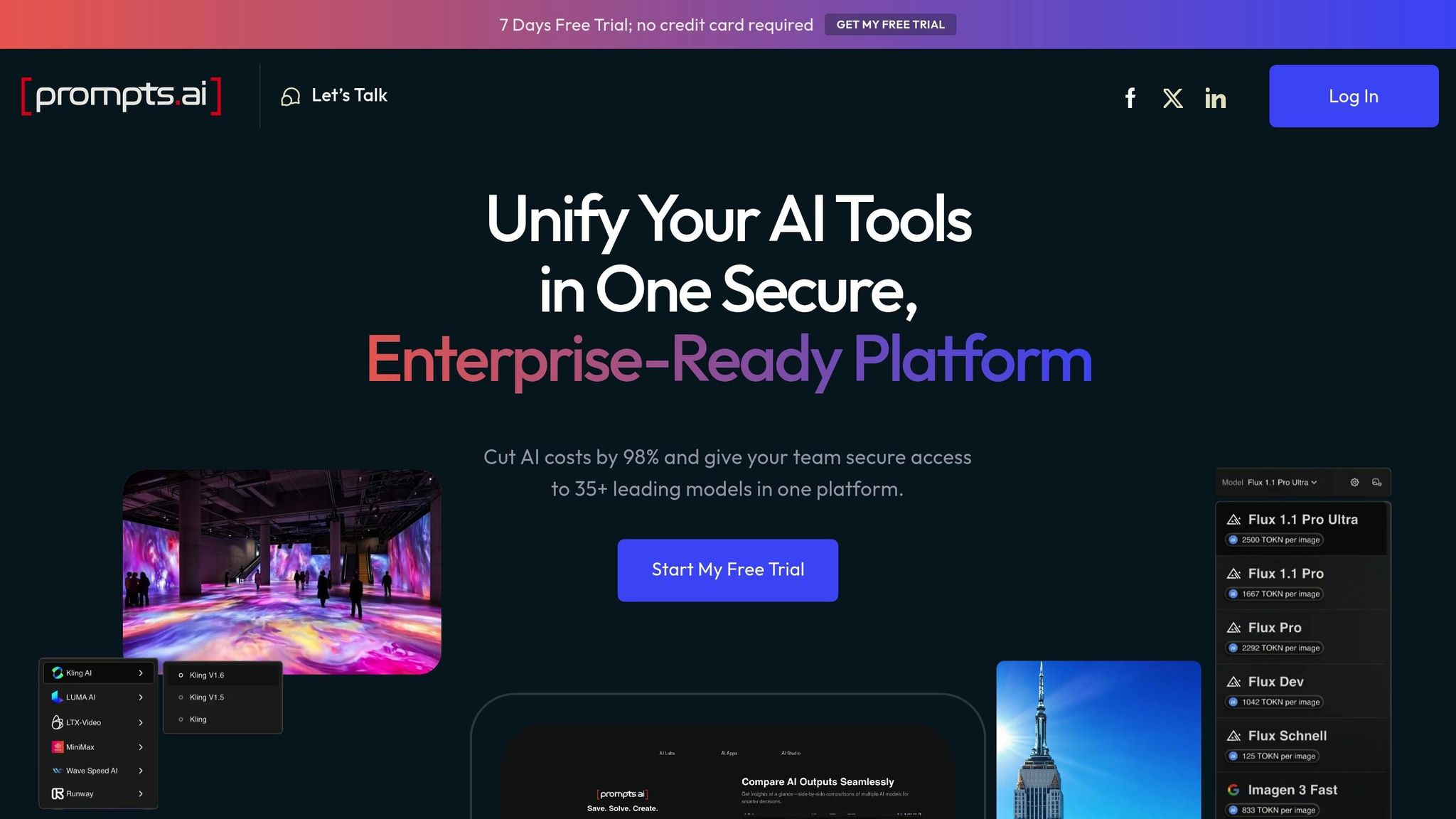
Prompts.ai brings together over 35 top-tier large language models, including GPT-4, Claude, LLaMA, and Gemini, into one secure and unified interface. By addressing the challenge of tool sprawl, the platform ensures streamlined AI workflows while prioritizing governance and cost efficiency.
One of Prompts.ai’s standout features is its ability to integrate diverse AI models into a single platform. Instead of juggling multiple subscriptions and interfaces, organizations can access models like GPT-4, Claude, and Gemini all in one place. This eliminates the hassle of switching between tools and ensures a smoother workflow.
The platform also supports side-by-side performance testing, where teams can run the same prompt across multiple models simultaneously. This feature is invaluable for determining which model works best for specific tasks without the burden of managing separate platforms. This unified setup simplifies automation and sets the stage for scaling AI operations effortlessly.
Prompts.ai transforms experimental AI efforts into consistent, standardized workflows. Teams can create repeatable workflows that bring uniformity across projects and departments. This consistency becomes essential as organizations expand their AI initiatives from small-scale trials to enterprise-wide deployments.
The platform’s design supports rapid scaling, allowing organizations to add new models, users, or teams in just minutes. With its Pay-As-You-Go TOKN credits system, Prompts.ai eliminates the need for fixed subscription fees, letting businesses align costs with actual usage. This flexibility makes it easy to scale up or down based on changing needs, avoiding unnecessary expenses.
Governance is at the heart of Prompts.ai’s framework. The platform offers complete visibility and control over all AI interactions, with detailed audit trails that track usage across models, teams, and applications. This transparency is crucial for meeting compliance requirements at scale.
To address security concerns, the platform ensures that sensitive data remains within the organization’s control. With built-in security features and compliance tools, businesses can confidently deploy AI workflows while adhering to their security protocols and regulatory standards.
Prompts.ai tackles hidden AI costs with its integrated FinOps layer, which tracks every token, provides real-time cost monitoring, and connects spending to business outcomes. This transparency helps organizations understand their AI expenses and adjust spending where needed.
By consolidating multiple AI tools into a single platform with usage-based pricing, Prompts.ai can reduce AI software costs by up to 98%. This approach not only saves money but also ensures access to a wide range of leading AI models without the complexity of managing separate subscriptions.
Prompts.ai supports a thriving community of prompt engineers and offers extensive training resources. Teams can take advantage of pre-built "Time Savers", which are ready-to-use tools designed to boost efficiency.
The platform’s Prompt Engineer Certification program helps organizations cultivate in-house AI experts who can guide teams in adopting best practices. Combined with hands-on onboarding and training, this community-driven approach ensures businesses can fully leverage their AI investments while continuously improving their workflows.
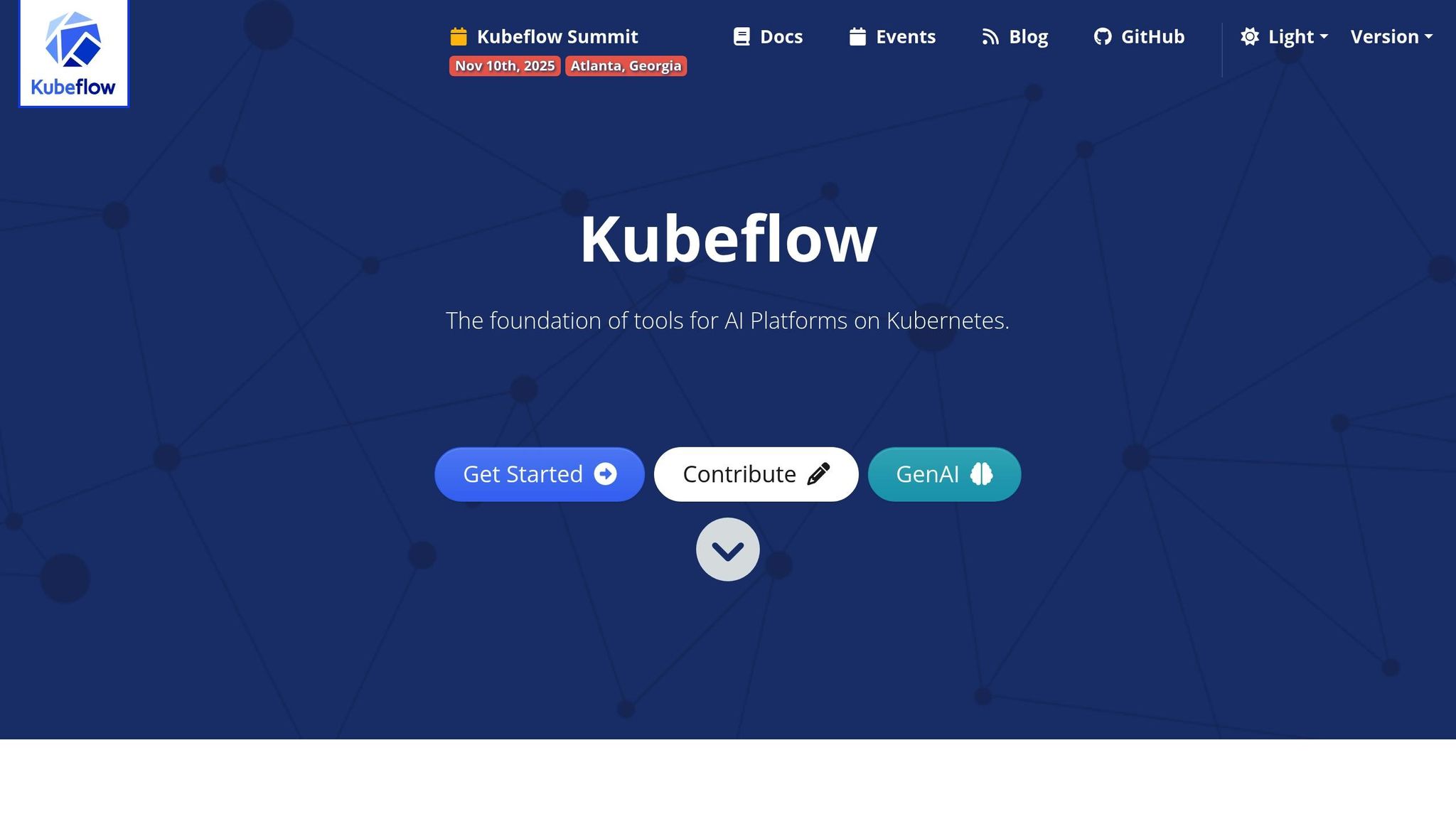
Kubeflow is an open-source platform designed to simplify and scale machine learning (ML) workflows, leveraging the power of Kubernetes. It streamlines the deployment and management of ML pipelines in production environments by using Kubernetes' container orchestration capabilities.
Kubeflow seamlessly integrates with existing Kubernetes infrastructure and cloud-native tools, offering support for a variety of ML frameworks like TensorFlow, PyTorch, XGBoost, and scikit-learn. This eliminates concerns about vendor lock-in, giving teams the freedom to work with the tools they prefer.
With Kubeflow Pipelines, organizations can create ML workflows that are portable across cloud and on-premises environments. This flexibility is particularly useful for businesses operating in multi-cloud setups or planning infrastructure migrations. Teams can define workflows once and deploy them consistently across development, staging, and production environments, ensuring uniformity and reliability.
The platform's notebook servers, which work effortlessly with tools like Jupyter, provide an intuitive interface for data scientists. These servers harness Kubernetes' resource management capabilities, allowing users to prototype locally and scale experiments without changing their development workflows. This tight integration lays the groundwork for automated and scalable ML processes.
Kubeflow transforms ML workflows into repeatable, automated pipelines. Using a domain-specific language, teams can define workflows that include dependencies, conditional logic, and parallel processing, making it easier to manage complex tasks.
Kubernetes' native horizontal scaling ensures that training jobs can dynamically access additional computational resources when needed. Kubeflow can deploy extra pods across nodes, efficiently distributing workloads while optimizing resource use and controlling costs.
The Katib component further enhances efficiency by automating hyperparameter tuning. By running multiple experiments simultaneously, Katib minimizes the time spent on manual optimization, allowing teams to focus on refining model architecture and feature engineering.
Kubeflow prioritizes secure and governed workflows, essential for production environments. By leveraging Kubernetes' role-based access control (RBAC), the platform provides detailed permission settings, enabling organizations to define who can access specific namespaces, create pipelines, or modify experiments. This ensures proper governance across ML workflows.
Additionally, Kubeflow offers audit trails for pipeline executions, model training runs, and data access patterns. These features help organizations meet regulatory requirements and simplify troubleshooting. Multi-tenancy support allows different teams or projects to operate within isolated namespaces, each with its own resources and access controls, ensuring both security and efficiency.
Kubeflow includes tools to manage and control costs effectively. Namespace-level resource quotas help limit compute spending, while the use of spot instances or preemptible compute resources from major cloud providers can lower training costs for non-critical tasks that can tolerate interruptions.
Pipeline caching is another cost-saving feature, as it reuses previously generated outputs when inputs remain unchanged, reducing both execution time and resource consumption.
Kubeflow promotes teamwork through shared notebook environments and centralized pipeline repositories. These features allow teams to share experiments and reproduce results, fostering collaboration. Experienced data scientists can create templates that less experienced team members can adapt for specific needs, enhancing productivity across the board.
The platform benefits from a thriving open-source community, with contributions from major organizations like Google, IBM, and Microsoft. Regular community meetings, special interest groups, and detailed documentation ensure ongoing support for users of all experience levels.
Kubeflow also integrates with tools like MLflow, enabling teams to maintain their existing workflows while taking advantage of Kubeflow's orchestration capabilities. This makes it easier for organizations to transition from other ML platforms without disrupting their processes.
Kubeflow's comprehensive features - from integration to governance - highlight how it simplifies and streamlines AI workflows, making it a powerful tool for modern ML operations.
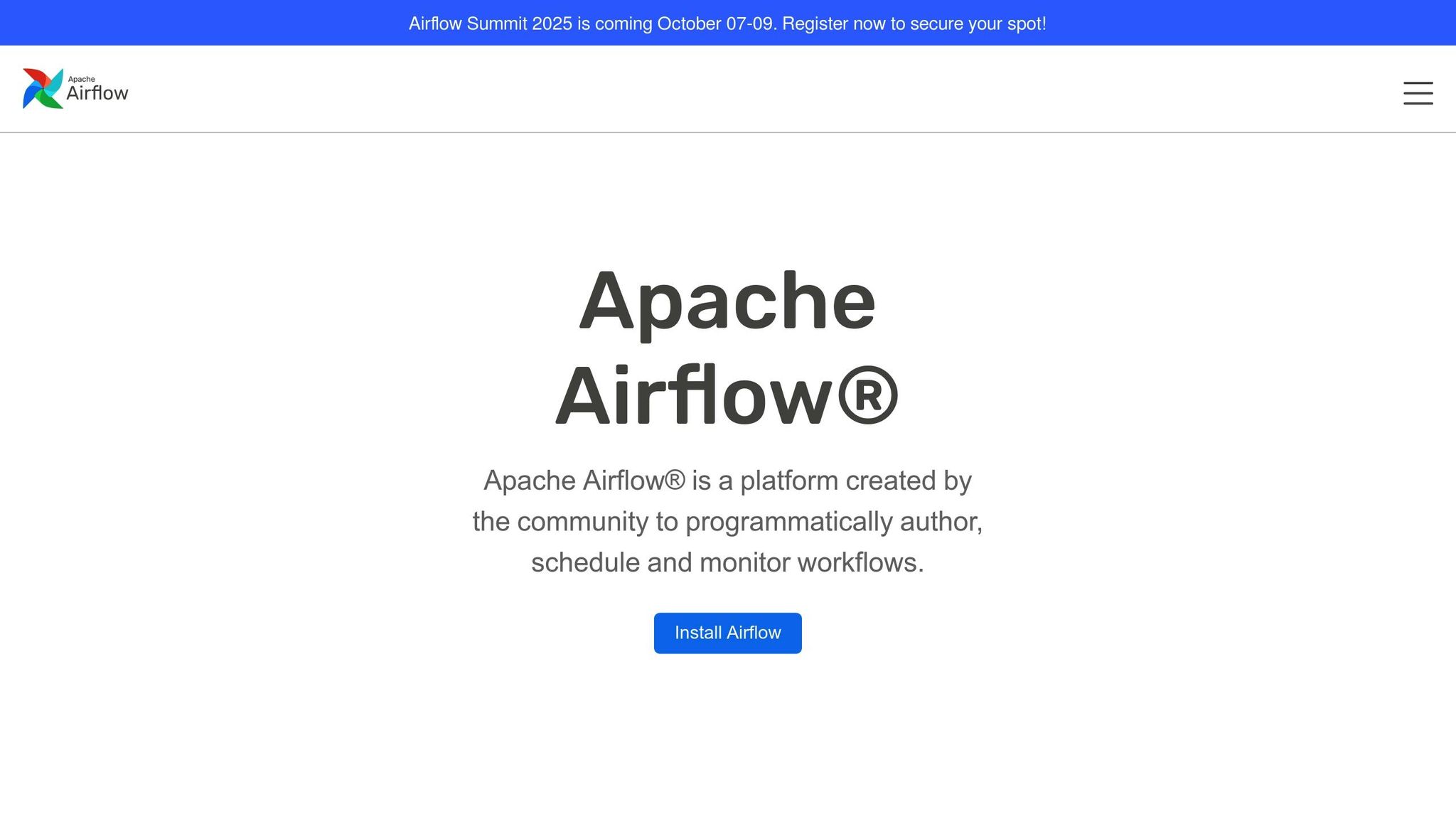
Apache Airflow is an open-source platform designed for building, scheduling, and monitoring workflows using Directed Acyclic Graphs (DAGs). Over time, it has become a go-to solution for managing complex AI and machine learning pipelines across a variety of environments.
Airflow stands out for its ability to connect different systems seamlessly. With a rich set of operators and hooks, it integrates effortlessly with popular services like AWS, Google Cloud Platform, Azure, Snowflake, and Databricks. This compatibility is particularly valuable for AI workflows that rely on multiple cloud providers and diverse data sources.
The platform’s Python-based framework allows users to define workflows as Python code. This flexibility enables dynamic pipeline creation and the inclusion of complex conditional logic - ideal for AI model training pipelines that need to adapt based on specific data characteristics.
Airflow’s XCom (cross-communication) system makes it easy to pass data between tasks, creating smooth transitions between steps like data preprocessing, model training, validation, and deployment. Teams can also develop custom operators to suit specific AI frameworks, such as TensorFlow, PyTorch, or scikit-learn, making it a highly adaptable tool for a wide range of AI projects.
Airflow’s scheduler automates workflows with precision, managing both standard and intricate timing and dependency requirements. This makes it an excellent choice for tasks like regular model retraining or batch inference.
For scalability, Airflow offers options like the CeleryExecutor and KubernetesExecutor, which distribute workloads across multiple worker nodes. This setup allows compute resources to scale dynamically based on task demand, enabling simultaneous processing of multiple experiments without manual oversight.
Parallel task execution is another key feature, particularly useful for AI workflows involving independent operations. Tasks such as feature engineering, hyperparameter tuning, and model validation can run concurrently, significantly reducing overall pipeline execution times.
To enhance reliability, users can configure tasks with features like exponential backoff, custom retry logic, and failure notifications, ensuring workflows remain robust even when infrastructure issues arise.
Airflow provides detailed task logging, role-based access control (RBAC) for granular permissions, and integration with secret management systems to secure sensitive data. These features not only enhance security but also help teams track the origins of model training processes, ensuring compliance with regulatory standards.
The platform supports encrypted connections and integrates with tools like HashiCorp Vault or cloud-native secret stores to safeguard critical information, such as database credentials and API keys. Additionally, its data lineage tracking capabilities allow organizations to trace how data moves through AI pipelines, aiding both debugging efforts and compliance audits.
Airflow’s resource-aware scheduling helps optimize compute costs by efficiently distributing tasks across available infrastructure. It supports the use of cost-effective options like spot and preemptible instances, making it an economical choice for intensive AI workflows.
Task pooling further enhances resource management by limiting the number of concurrent executions for resource-heavy operations. This is especially beneficial when running multiple AI training jobs that demand significant GPU or memory resources.
The platform’s monitoring and alerting features provide visibility into resource usage, helping teams identify areas for optimization. Metrics like task duration, resource consumption, and queue depths offer valuable insights for fine-tuning workflows.
Airflow fosters collaboration by encouraging workflow definitions in code, enabling teams to leverage practices like version control and code reviews. This approach ensures transparency and consistency in workflow development.
The platform is backed by a thriving community of contributors. Regular community meetings, detailed documentation, and extensive example repositories make it easier for organizations to adopt and implement AI workflow orchestration with Airflow.
Developers can share templates for common AI use cases, such as model training, validation, and deployment, promoting reusable best practices. Additionally, the plugin architecture allows teams to create custom extensions while maintaining compatibility with Airflow’s core features, adding even more flexibility to this powerful tool.
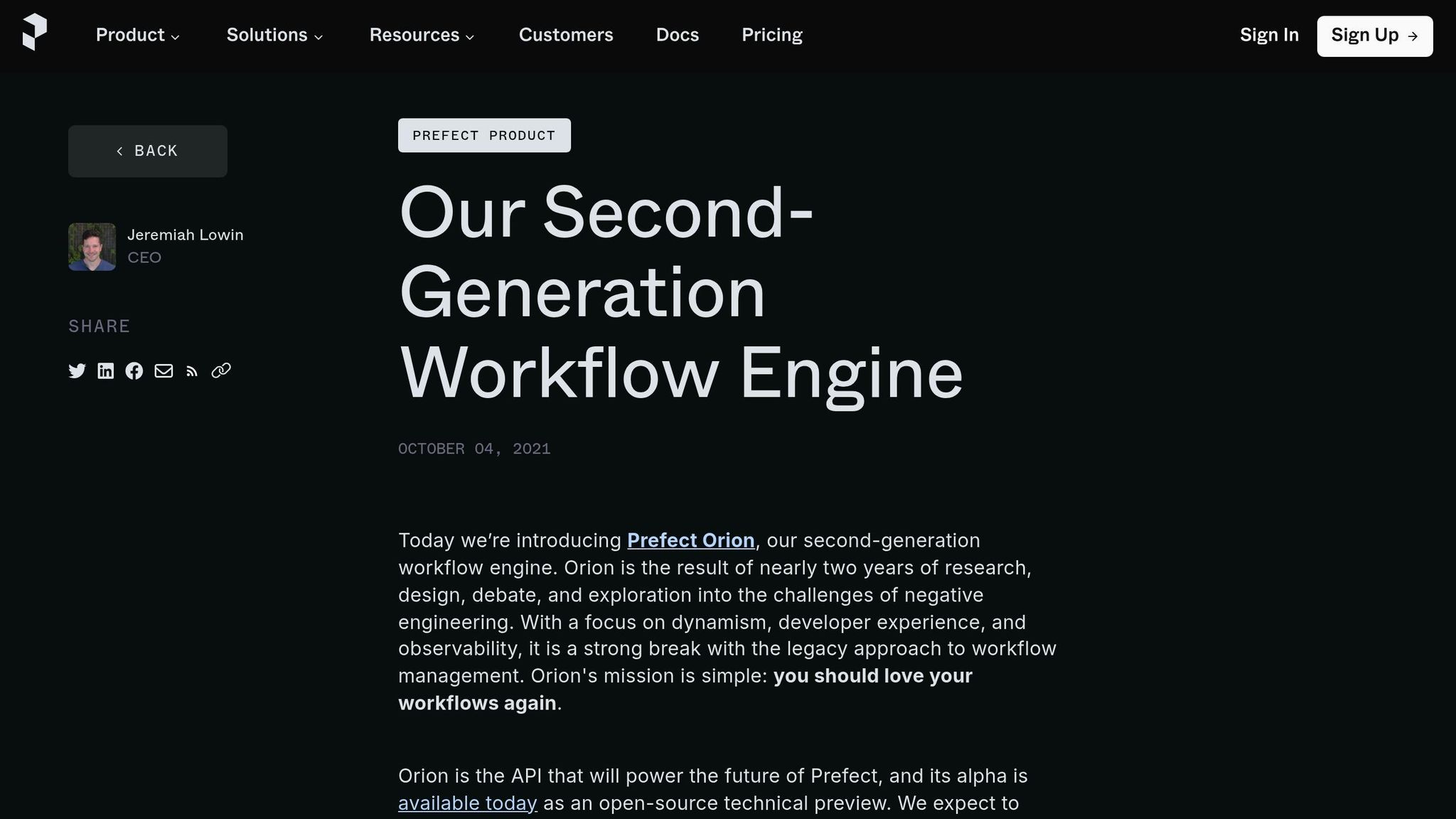
Prefect Orion follows a shared responsibility model. In this setup, Prefect takes charge of the orchestration control plane, which includes managing metadata storage, scheduling, API services, authentication, and user management. This approach ensures consistent high availability, automatic scaling, and reliable service delivery. By aligning with the advanced automation features previously mentioned, this governance framework enhances the platform's operational efficiency.
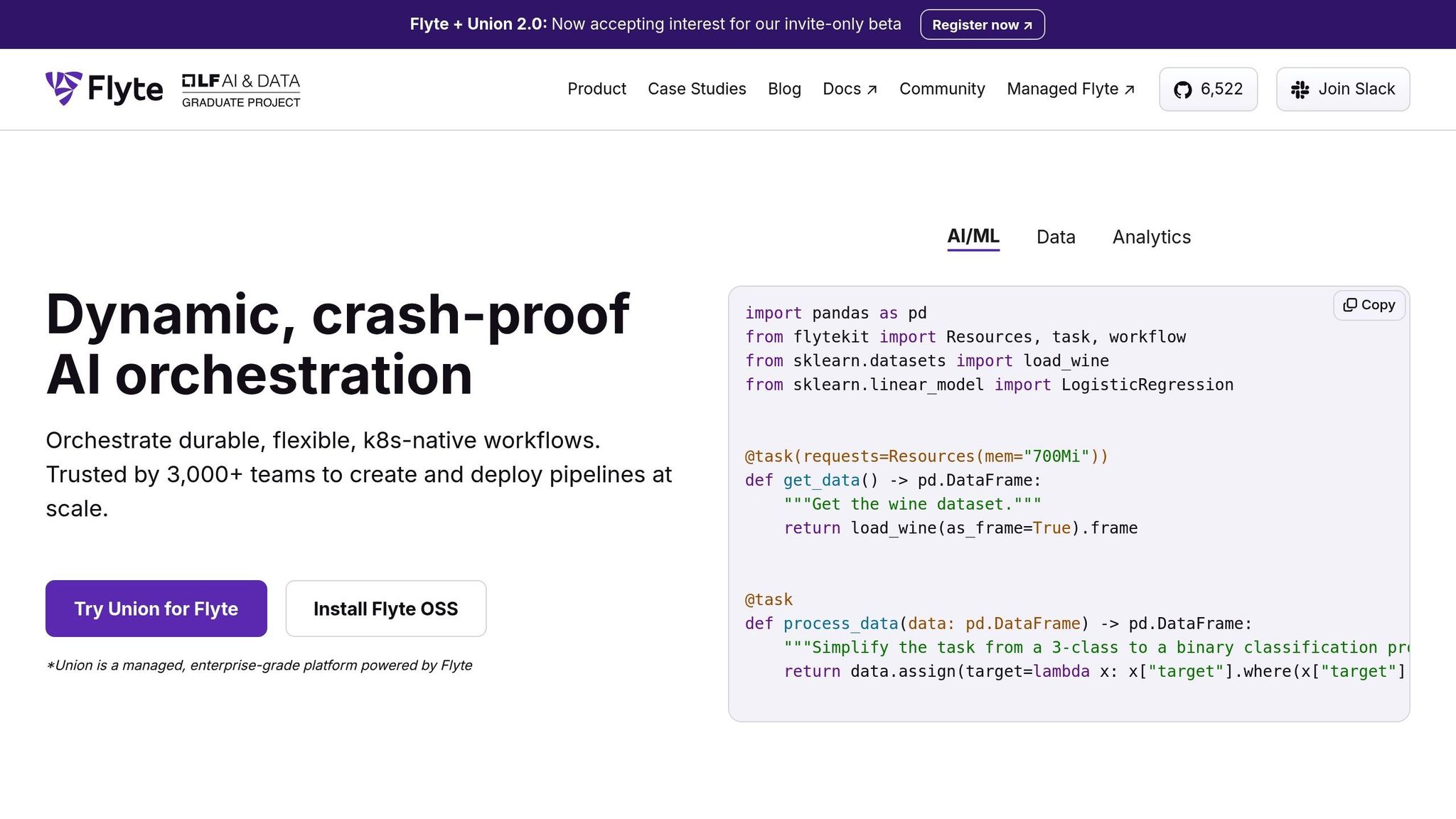
Flyte is a fully open-source platform crafted to orchestrate workflows, particularly for machine learning and data science projects. Its management by an open-source Foundation ensures it remains a community-focused tool.
Flyte's governance structure, maintained by its open-source Foundation, offers transparent oversight and features like native versioning for dependable audit trails. Its strongly typed interfaces safeguard data integrity and automatically document data provenance, making it a reliable choice for organizations prioritizing security and accountability. These features also enhance the platform's ability to automate processes effectively.
The platform's type-safe architecture is designed to catch type mismatches and data format errors before workflows run. This preemptive error detection ensures smoother execution of complex AI pipelines, reducing the need for manual fixes and boosting overall reliability. Such technical dependability makes it easier for teams to scale their operations efficiently.
Flyte thrives under its open-source Foundation governance, which nurtures an active and diverse community of contributors from various organizations. Its focus on reproducibility ensures workflows are consistent, simplifying team collaboration and easing the onboarding process for new members.
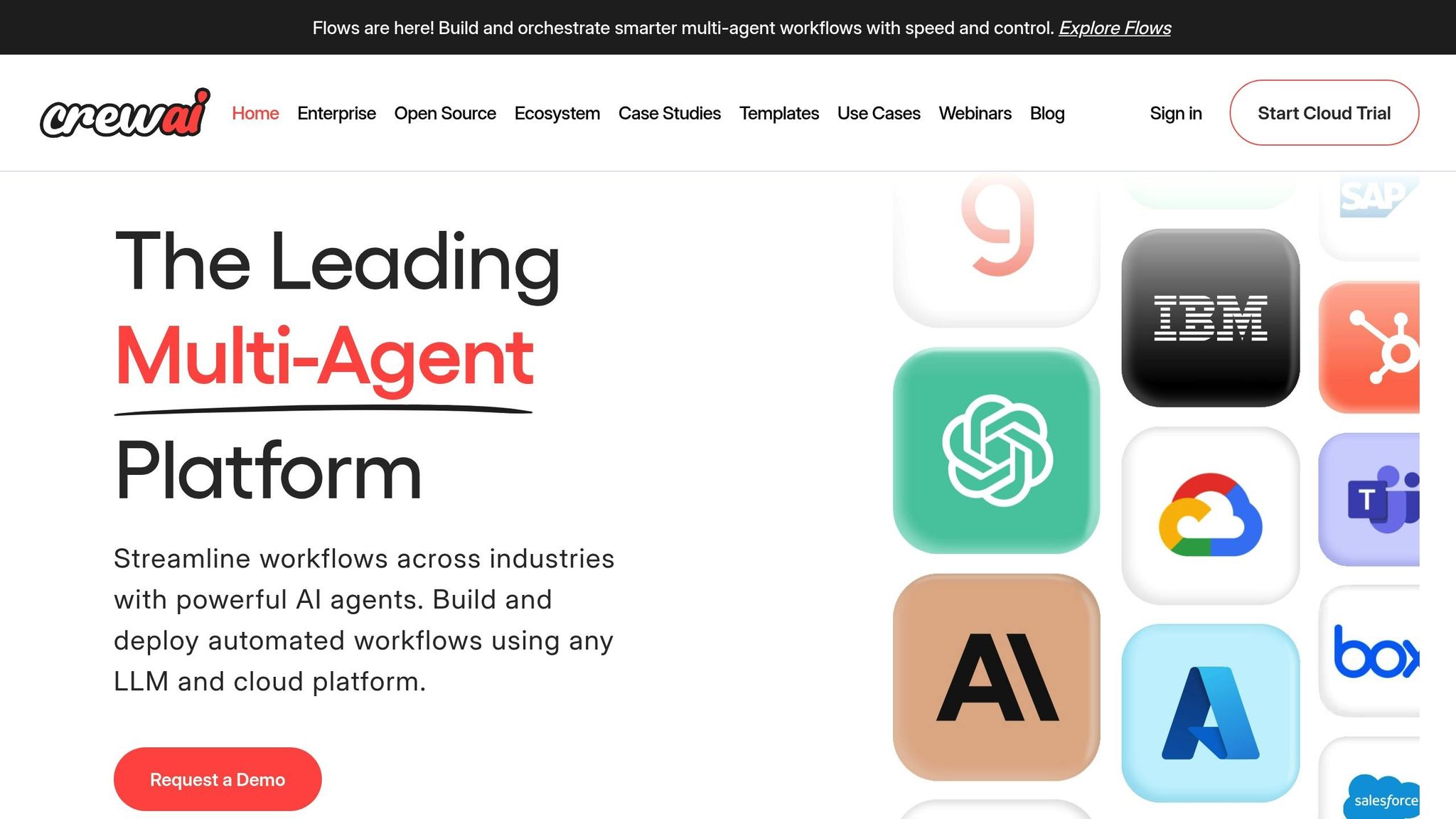
CrewAI is an independent Python framework designed to coordinate multiple AI agents, delivering quicker execution and dependable results for intricate workflows.
CrewAI's architecture ensures smooth integration across various AI ecosystems. It works with any large language model or cloud platform, and it also supports local models through tools like Ollama and LM Studio. This flexibility allows organizations to stick with their preferred models. Its RESTful interfaces and webhook configurations simplify external system connections by managing authentication, rate limits, and error recovery automatically. CrewAI Flows further enhance integration by connecting with databases, APIs, and user interfaces. They combine different AI interaction patterns, such as collaborative agent teams, direct LLM calls, and procedural logic.
For instance, Latenode has successfully integrated with CrewAI, linking agents to enterprise systems like CRMs, databases, and communication tools through its visual workflow builder and over 300 pre-built integrations. This setup enabled tasks such as syncing outputs to Google Sheets or triggering Slack notifications based on workflow events. Such seamless integration paves the way for efficient automation and scalable solutions.
CrewAI takes automation and scalability to the next level, leveraging its interoperability features. Its streamlined architecture and optimized codebase deliver 1.76x faster execution in QA tasks. The platform also includes built-in tools for web scraping, file processing, and API interactions, reducing the need for additional dependencies and simplifying workflow management. Teams can define complex business processes using YAML configuration files or Python scripts, enabling the creation of detailed agent interactions, data flows, and decision trees. This approach allows organizations to manage scalable workflows without requiring advanced programming skills.
The CrewAI community continues to expand, earning recognition from industry leaders. Ben Tossell, Founder of Ben's Bites, praised the framework, saying:
"It's the best agent framework out there and improvements are being shipped like nothing I've ever seen before!"
Developers can enhance CrewAI by creating custom Python agents or designing structured Crews and Flows, making it easier to manage agent interactions on a larger scale.
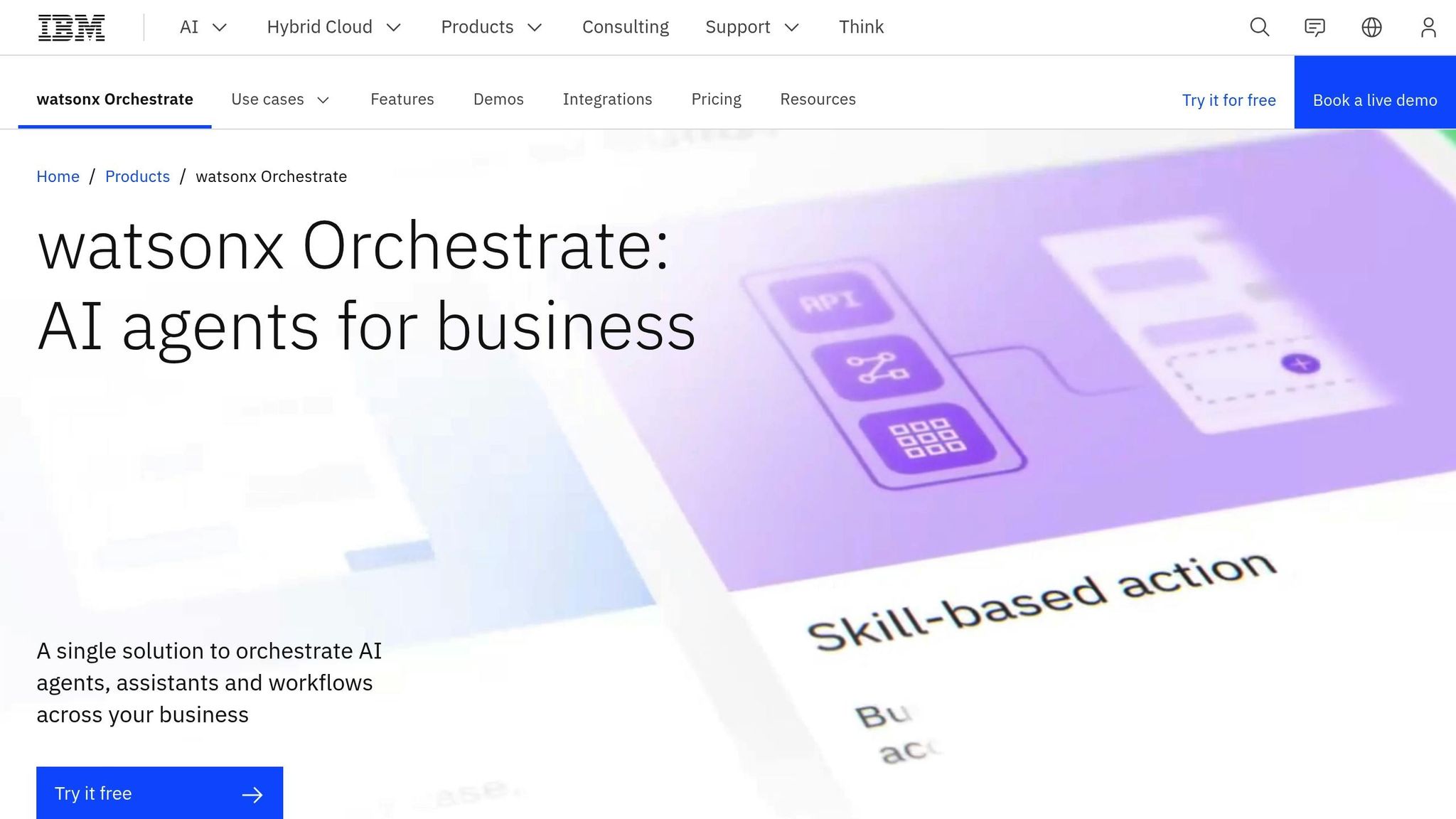
IBM watsonx Orchestrate is a powerful enterprise tool designed to streamline and automate complex AI workflows, seamlessly connecting various business applications.
Using REST APIs and custom connectors, IBM watsonx Orchestrate bridges the gap between older systems and modern platforms. It supports both on-premises and cloud-based deployments, offering flexibility to fit different operational needs.
The platform provides an intuitive interface that simplifies the creation and deployment of automated workflows, even for users with limited technical skills. It’s built to handle fluctuating workloads, ensuring dependable performance during peak times.
IBM watsonx Orchestrate prioritizes enterprise-level security with advanced access controls, robust data protection measures, and thorough monitoring. These features ensure compliance and maintain transparency across all operations.
With tools for real-time resource tracking and cost optimization, the platform allows businesses to make informed adjustments to workflows. These capabilities integrate effortlessly with enterprise systems, helping businesses maintain efficient and scalable AI operations.
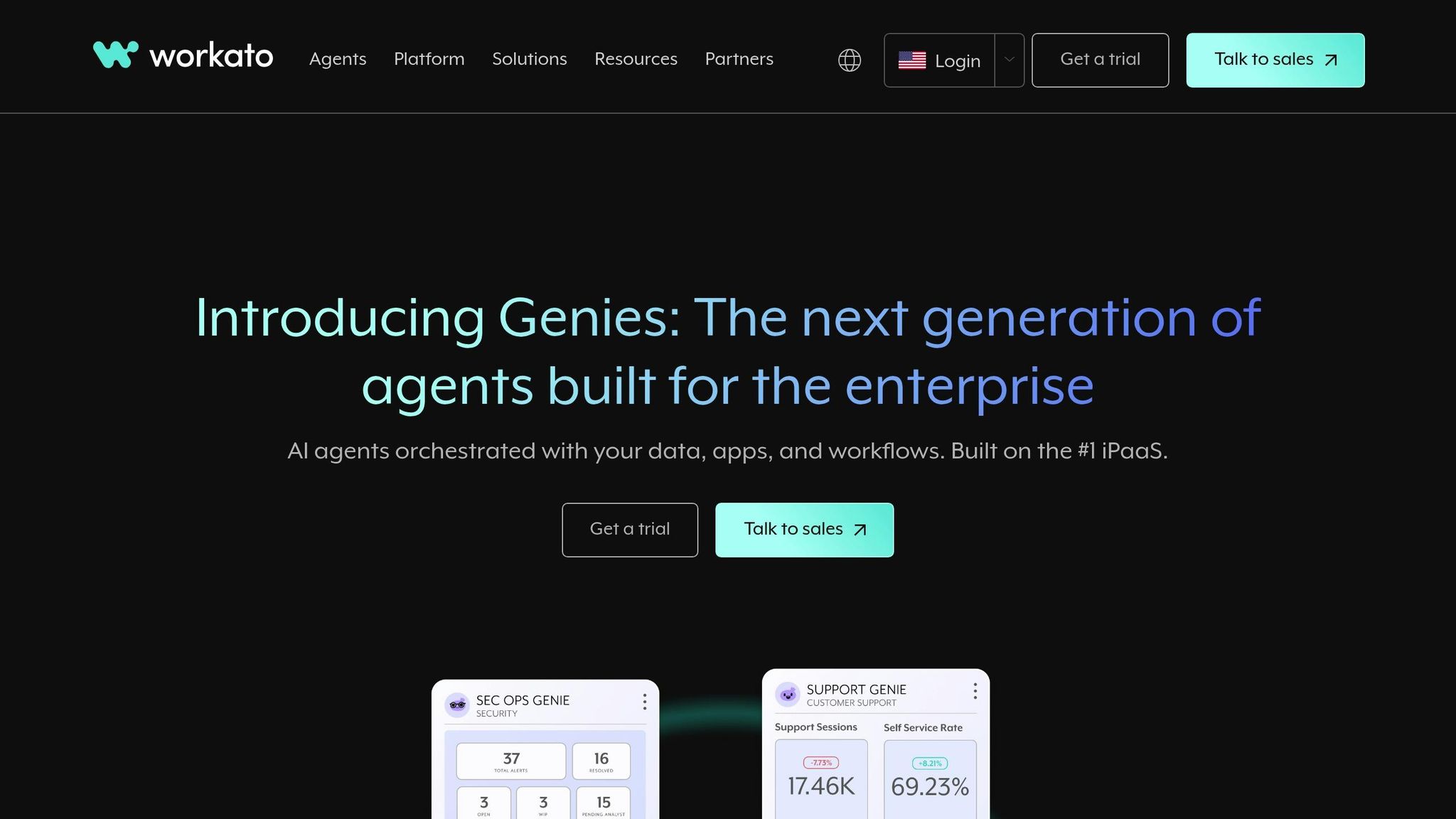
Workato provides a powerful platform that connects various systems and simplifies AI workflow automation. Acting as a vital link between enterprise applications and AI-driven processes, it ensures seamless integration and reliable performance while supporting the scalability needed for growing demands.
Workato stands out with its ability to connect diverse systems using an extensive library of over 1,000 pre-built connectors, along with support for REST APIs, webhooks, and custom integrations. It facilitates smooth data exchange across legacy systems, cloud applications, and modern AI tools, effectively breaking down data silos that often disrupt AI workflows. With its universal connector framework, businesses can integrate nearly any system, from CRM tools like Salesforce to data warehouses and AI model endpoints, enabling consistent data pipelines that power AI processes efficiently.
Workato simplifies the creation of advanced AI workflows using its visual recipe builder, allowing users to design complex orchestration logic without needing deep coding expertise. The platform handles dependencies across various stages of AI workflows, such as data preprocessing, model training, and deployment, while dynamically scaling resources to meet workload requirements. Its enterprise-level infrastructure supports high-volume data processing and manages thousands of workflows running simultaneously, making it an excellent choice for organizations managing multiple AI projects across departments and use cases.

Cloud-native orchestration tools from major providers like AWS, Azure, and Google offer seamless, scalable workflows tailored to their ecosystems. These platforms streamline the entire machine learning lifecycle, from data preparation to model deployment, making them invaluable for enterprises seeking integrated solutions.
Each platform excels in connecting with its broader ecosystem and supporting diverse machine learning frameworks:
These integrations not only streamline processes but also enable dynamic scaling, ensuring flexibility and efficiency in handling diverse workloads.
Automation and scalability are at the heart of these platforms, allowing organizations to handle complex AI workflows with ease:
This section dives into the unique advantages and limitations of each platform, offering a clear understanding of how they stack up against one another. By examining these differences, organizations can align their choices with specific goals, technical needs, and budgets. The following overview provides context for a detailed side-by-side comparison of key features.
Prompts.ai offers a streamlined solution to the challenge of managing multiple AI tools. With access to over 35 language models through a unified interface, it eliminates the need for juggling numerous subscriptions. Its built-in FinOps capabilities enable real-time cost tracking and optimization, with the potential to cut AI software expenses by as much as 98%. However, for organizations heavily invested in specific cloud environments, cloud-native solutions may provide smoother integration with existing systems.
Kubeflow shines in Kubernetes-native setups, delivering robust MLOps capabilities and benefiting from strong community support. Its modular design lets teams pick and choose components as needed. On the downside, Kubeflow demands advanced Kubernetes expertise, which can be a barrier for smaller teams lacking dedicated DevOps resources.
Apache Airflow is a trusted name in workflow management, known for its extensive plugin ecosystem and proven reliability across various industries. Its Python-based framework appeals to both data scientists and engineers. That said, it may struggle with real-time processing and can become resource-heavy as workflows scale, requiring careful resource planning.
Prefect Orion addresses some of Airflow's limitations, particularly in hybrid cloud deployments. Its modern architecture, user-friendly interface, and improved error handling make it easier to use. However, as a newer platform, it offers fewer third-party integrations and a smaller community compared to more established options.
Flyte stands out with robust data lineage tracking and reproducibility features, making it a strong choice for research-focused organizations. Its type-safe approach minimizes runtime errors and boosts workflow reliability. However, it comes with a steeper learning curve, especially for teams unfamiliar with its unique paradigms.
CrewAI simplifies multi-agent AI workflows, providing an intuitive framework for coordinating various AI agents. While it performs well for specific use cases involving agent collaboration, it may lack the orchestration depth needed for more complex enterprise workflows.
IBM watsonx Orchestrate integrates seamlessly with IBM's AI ecosystem and delivers strong governance features tailored for enterprise needs. However, its appeal may be limited for organizations not already invested in IBM's technology stack, especially when compared to vendor-neutral alternatives.
Workato excels in automating business processes, offering over 1,000 pre-built connectors. While it’s highly effective for traditional workflows, its capabilities may not extend as well to managing complex AI models.
Here’s a comparison table summarizing the key differentiators:
| Platform | Interoperability | Automation Level | Governance | Cost Management | Setup Complexity |
|---|---|---|---|---|---|
| Prompts.ai | Multi-model support, API integrations | High (workflow automation) | Enterprise-grade | Real-time FinOps tracking | Low to Medium |
| Kubeflow | Kubernetes-native, ML frameworks | High (MLOps focused) | Role-based access | Resource optimization | High |
| Apache Airflow | Extensive plugins, databases | Medium (task scheduling) | Basic to Medium | Manual monitoring | Medium |
| Prefect Orion | Cloud-agnostic, modern APIs | High (flow management) | Improved governance | Usage-based insights | Medium |
| Flyte | Multi-cloud, data lineage | High (reproducible workflows) | Strong versioning | Resource allocation | High |
| CrewAI | Agent coordination, LLM APIs | Medium (agent-specific) | Basic | Limited built-in tools | Low |
| IBM watsonx Orchestrate | IBM ecosystem, enterprise apps | High (business processes) | Enterprise compliance | IBM pricing model | Medium to High |
| Cloud-native Solutions | Native cloud services | Very High (managed services) | Cloud provider controls | Pay-per-use models | Medium |
When it comes to costs, cloud-native platforms generally operate on pay-as-you-go pricing, scaling with usage. In contrast, enterprise platforms like IBM watsonx Orchestrate often involve significant upfront licensing fees.
Selecting the right platform often means balancing governance needs with implementation complexity. Teams prioritizing cost efficiency and flexibility across multiple models may lean toward Prompts.ai, while those deeply integrated into specific cloud ecosystems may find cloud-native platforms more practical, despite potentially higher long-term expenses.
Orchestrating AI workflows effectively is key to synchronizing complex processes and achieving meaningful results. Selecting the right platform depends on your organization’s specific needs, technical expertise, and long-term objectives. The current market offers a variety of options, from comprehensive enterprise platforms to cloud-native services, each catering to unique requirements.
For businesses juggling multiple AI tools and rising costs, Prompts.ai stands out as a solution for centralized management and cost efficiency. If your team is well-versed in Kubernetes, Kubeflow provides a modular framework tailored for MLOps-heavy workflows. However, smaller teams without dedicated DevOps resources may find its complexity challenging. On the other hand, Apache Airflow remains a go-to choice for established data teams due to its reliability and extensive plugin ecosystem, though scaling workflows with Airflow demands careful resource allocation. For organizations focused on modern architecture, Prefect Orion offers a user-friendly alternative that addresses some of Airflow’s limitations. Meanwhile, research-driven teams may benefit from Flyte, which excels in specialized capabilities but requires time to master its unique approach.
When tackling AI workflow orchestration, it’s crucial to consider governance, ease of implementation, and cost structure. Unified platforms like Prompts.ai are ideal for teams needing flexibility across various AI models while keeping expenses in check. Conversely, organizations already embedded in specific cloud ecosystems may lean toward cloud-native options, even if they come with higher long-term costs.
Ultimately, success in AI orchestration lies in aligning platform features with your organization’s goals and technical readiness. Start by identifying your pain points and assessing your team’s capacity, then choose a platform that can evolve alongside your AI initiatives.
When choosing an AI workflow orchestration platform, it's crucial to weigh several important factors. Start by assessing the platform's scalability, ensuring it can grow alongside your needs. Check its compatibility with your current tools and systems, as seamless integration minimizes disruptions. Additionally, look for features tailored to your industry-specific requirements, which can make a significant difference in meeting unique challenges.
Another critical aspect is how well the platform handles data integration, model management, and governance. These capabilities ensure smooth operations, better oversight, and compliance with necessary regulations. Don’t forget to align your choice with your organization's technical resources and future expansion plans. A well-rounded platform should simplify workflows, improve operational efficiency, and support long-term growth. By focusing on these factors, you can select a solution that strengthens your AI workflows and aligns with your strategic goals.
Prompts.ai slashes AI software expenses by automating workflows and consolidating access to AI models, helping businesses drastically lower operational costs. By reducing the need for manual intervention and simplifying processes, organizations can boost efficiency and save as much as 98%.
This streamlined approach not only cuts costs but also optimizes AI project budgets, enabling smarter resource allocation. With these savings, teams can expand their AI efforts more cost-effectively while ensuring top-notch performance and reliability.
Cloud-native solutions excel in scalability thanks to features like elastic resource allocation, auto-scaling, and stateless services. These tools empower systems to handle increasing workloads effectively while staying resilient. Additionally, they integrate smoothly with cloud services and microservices, enabling quicker deployments and better compatibility across platforms.
In contrast, traditional platforms often depend on vertical scaling, which involves boosting resources on existing servers. This method has its limits - both physically and in terms of flexibility - often leading to over-provisioning and challenges when integrating with modern, distributed systems. For businesses looking to streamline AI workflows, cloud-native solutions offer a more flexible and forward-thinking foundation.


